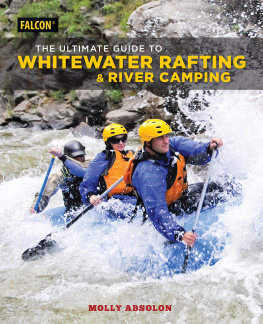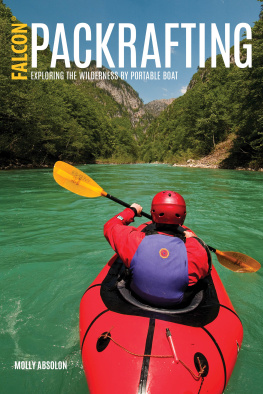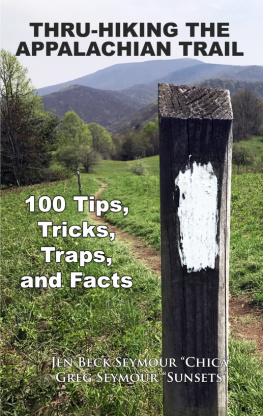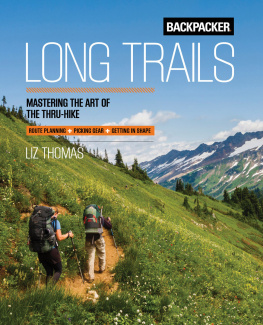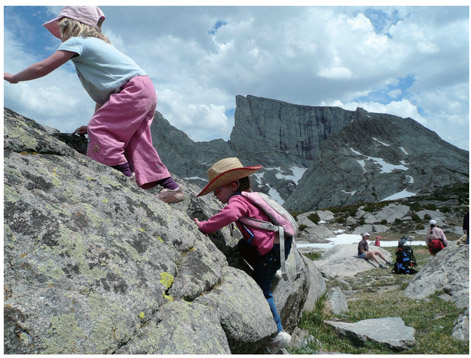ABOUT THE AUTHOR
Molly Absolon is a former NOLS instructor, an environmental educator, and outdoor writer. She is the author of the Backpacker magazines Campsite Cooking, Trailside Navigation, Trailside Recipes, Trailside First Aid, and Outdoor Survival. She has recently moved to Victor, Idaho.
Chapter One
Getting Started
CHOOSING YOUR DESTINATION
Great outdoor destinations are ones that allow children to use their imagination and run free. Some of the best hikes I had with my daughter were on rock outcrops around our home in Wyoming. She could climb over boulders, slither through slot canyons, and slide down the slickrockall components of a great outdoor adventure for kids. My own favorite childhood memories of being outdoors also center on rock outcrops that were riddled with caves and tunnels for us to play in.
Look for places that include:
mossy, ferny, drippy nooks that could house fairies, elves, and leprechauns
water to splash, swim, and play in
boulders or rock slabs to climb on
modest peak ascents with lots of scrambling
snow to slide on and build things with
beaches with tidal pools to poke around in or shells to collect
places with birds and wildlife to watch
mud or sand to construct castles or just glop around in
rocky shorelines for skipping stones
Rocky outcrops make natural playgrounds. SCOTT KANE
As your children get older, your destination choices will shift to match their changing interests. You may find they want to go fishing or it may be critical for them to bring a friend along during those social years. Teenagers often respond well to challenges, so a third-class peak ascent that involves scrambling and big views may be just the kind of adventure that gets them excited. You can also bring a rope and set up climbs to provide a fun activity. Find a campsite by a good swimming hole or a natural waterslide. Often teens arent all that different from adults in the kinds of objectives that motivate them down the trail.
Allow time to explore and play during your hike so children can get the most out of their experience. MOLLY ABSOLON
How Far Can You Go?
Appropriate distances are hard to pinpoint. What works for one child may not work for another. Plus when you add in variables such as temperature, distractions, and terrain, you quickly realize that a mile-long hike in one location is very different from a mile-long hike in another. That said, it can be helpful to have a few guidelines for selecting hikes if you are unfamiliar with the trails and need to decide whats appropriate for your child. Dont forget to weigh in your childs skill and experience level when using these guidelines. You probably should not take an eight-year-old on a 9-mile hike if its her first time.
01 year old: When your child is riding on your back, you can go as far as you are willing to walk and as long as your child is willing to sit. Some kids fall right to sleep when they get into a backpack and will snooze there for hours; others need to move around occasionally. Regardless, your hiking ability is probably more important than your childs at this stage.
12 years old: Toddlers like freedom, so once they are ambulatory, you can expect they will want to walk on their own for at least part of the time. Realistically, kids this age end up walking less than a mile; bring along your baby backpack so you can carry them farther once they get tuckered out.
24 years old: As children gain strength and co-ordination, they can tackle longer hikes. Preschoolers are capable of walking 1 to 2 miles on their own with some encouragement and lots of snacks.
46 years old: Kids this age will amaze you. If they are having fun and feel as if hiking is playing, they can tackle a significant hike. Look for routes between 2 and 4 miles long.
69 years old: Under the right conditions, children this age can easily hike 5 or 6 miles, more if they are strong, motivated, and having a good time.
912 years old: Up to 10 miles is probably the limit. But take care not to turn your hike into a death march or you will quickly dampen their enthusiasm for future adventures.
Recognize Risks to Stay Safe
One thing to consider when choosing a kid-friendly destination in the outdoors is the potential danger you may encounter. An icy mountain stream raging next to your campsite creates a pleasant wilderness atmosphere for adults but can be a death trap for a three-year-old. Likewise a campsite located on a precipitous rocky ledge may have great views and low impact, but you probably wont have a moment of peace during your stay if you can never take your eyes off your toddler.
Anyone who has put pads on the corners of their tables, gates around their woodstoves, and barriers at the top of the stairs knows that kids dont really grasp the idea of danger very well. Its the same in the outdoors. You need to think about potential hazards when choosing an appropriate destination for your hike or campsite.
Scrambling hikes where the consequences of a fall are minimal are great for keeping kids entertained and parents relaxed. MOLLY ABSOLON
The big potential killers in the wildernessfor all agesinclude:
drowning
falls
exposure
People worry about wild animalsbears, mountain lions, and snakesand its true if you are in these animals habitats youll want to take some special precautions to avoid encounters. But in fact few people have bad experiences with wild animals. The accounts of attacks are sensational, but the numbers are very, very low. So dont avoid hiking in Yellowstone National Park, for example, because you are afraid of grizzly bears. Be smart, follow basic guidelines, keep tabs on your children, and you will be fine.
In Chapter Seven youll find detailed information about recognizing and managing risks with children in the backcountry. For now I just want to focus on the idea that you may want to consider potential hazards when selecting a destination to explore with your kids. Wandering along a small babbling brook with a youngster is probably going to be a lot less stressful than hiking along an icy torrent.
Destinations where your children are free to explore and play without constant supervision are great for developing a childs sense of independence and curiosity. SCOTT KANE
That said, the wilderness is a great place to begin teaching your children personal responsibility. Theres no better way to learn to take care of your gear than to wake up the morning after a storm to find your boots full of water and your clothes soaking wet. The trick is to make sure the choices your children make are age appropriate and have acceptable consequences. You can let them try crossing a stream on a slippery log if a fall just means getting wet; but if the log goes over a boulder-choked section of whitewater, its not a good place to learn.
You can discover a lot about your destination by talking to people whove been there, reading guidebooks, and checking out maps. Ask about river crossings, exposed sections of trails, and animal hazards before you go. Start with something mellow. Children dont need a lot of drama in the landscape or challenge in the terrain. They find magic in empty boxes and blankets draped across couches, so it doesnt take much to keep them entertainedand the less stressed by potential hazards you are, the more youll be able to enjoy the experience with your child.


